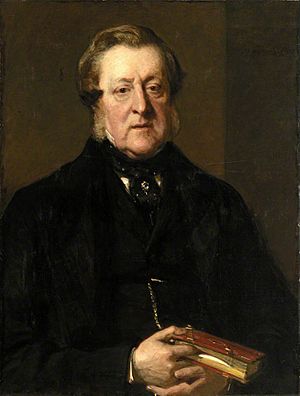William Tite facts for kids
Quick facts for kids
William Tite
|
|
|---|---|

William Tite, portrait c.1863
|
|
| Member of Parliament for Bath |
|
| In office 5 June 1855 – 20 April 1873 |
|
| Preceded by | Thomas Phinn |
| Succeeded by | Viscount Chelsea |
| Personal details | |
| Born | 7 February 1798 City of London, England |
| Died | 20 April 1873 (aged 75) Torquay, Devon, England |
| Political party | Liberal |
Sir William Tite (born February 7, 1798 – died April 20, 1873) was a very important English architect. He was known for designing many buildings in London, especially railway stations and cemetery projects. He was also a Member of Parliament (MP) for the city of Bath from 1855 until he passed away. He even served twice as the President of the Royal Institute of British Architects, which is a big deal for architects!
Contents
Early Life and First Projects
William Tite was born in London in February 1798. His father, Arthur Tite, was a merchant.
William started his career by training with David Laing, who was a famous architect. William helped Laing rebuild St Dunstan's church. Some people even say that William Tite designed the whole church himself!
Later, in 1827, Tite designed a Scottish church in London. It was built in a Gothic Revival style, which means it looked like old Gothic churches, similar to York Minster. He also helped design the main office for the London & Westminster Bank in the city.
Designing the Royal Exchange
One of William Tite's biggest and most famous projects was rebuilding the Royal Exchange in London. The old building had been destroyed by a fire in 1838.
A competition was held to find a new design. William Tite's design won! His building has a grand entrance with eight columns, inspired by the ancient Pantheon in Rome. The other parts of the building look like Italian Renaissance style. The new Royal Exchange opened in 1844.
Building Train Stations
William Tite was also a very busy architect for many early railway companies. He designed many train stations in Britain and even some in France! His station at Rouen in France was very impressive, spanning almost 90 feet.
Here are some of the train stations he designed:
- Stations for the London and South Western Railway like Vauxhall, Southampton, Gosport, and Windsor Riverside.
- Stations for the London and Blackwall Railway at Minories and Blackwall (built in 1840).
- Stations like Carnforth, Carlisle Citadel, and Lancaster Castle (built between 1846 and 1847).
- Many stations for the Caledonian and Scottish Central railways, including Perth (1847–1848).
- Stations like Barnes, Barnes Bridge, Chiswick, and Kew Bridge railway station (built in 1849).
- Stations between Yeovil and Exeter, such as Axminster and the old Honiton.
His station at Carlisle was built in a style called "neo-Tudor." It had a long front, about 400 feet, with an arcade of five arches in the middle. The dining rooms inside even had a special old-fashioned look with wooden roofs!
Designing Cemeteries
William Tite also designed several important cemeteries. He was a director of the South Metropolitan Cemetery Company. In 1836, he designed his first cemetery at Norwood. He created many important monuments and chapels there.
Before Tite, cemeteries usually looked like classical gardens. But Tite's design was the first to mix the Gothic revival style with beautiful landscaping. This style became a model for many cemeteries built after his.
From 1853 to 1854, he helped design Brookwood Cemetery near Woking in Surrey. This cemetery was special because it had its own train service from a station near Waterloo station in central London!
He also built a memorial church in the Byzantine style at Gerrards Cross between 1858 and 1859.
Later Life and Achievements
William Tite stopped working actively as an architect about 20 years before he died. However, he was still honored for his amazing work. In 1856, he received the RIBA Royal Gold Medal, which is a very high award for architects.
In 1855, he became a Member of Parliament for Bath. He served as an MP until his death. He was also made a knight in 1869, which means he was called "Sir William Tite."
Sir William Tite loved books and knew a lot about English literature. He was also good at languages. He was a member of the Royal Society and the Society of Antiquaries of London. He even served as President of the Royal Institute of British Architects.
He was involved in many other important roles, including being a director of the London and Westminster Bank. He was also a Governor of St. Thomas's Hospital in London. Today, a scholarship for excellent students at King's College London is named after him.
Sir William Tite passed away on April 20, 1873, in Torquay. He was buried in the catacombs of his own South Metropolitan Cemetery. A street in London, Tite Street, is named after him.
Gallery of Architectural Work







